FDN005 Foundations: TESCO Management Model and PESTLE Analysis
VerifiedAdded on 2023/06/10
|10
|2453
|263
Report
AI Summary
This report provides an analysis of TESCO's business management, focusing on the application of a suitable management model and a PESTLE analysis of its macro environment. It begins with an overview of TESCO PLC, highlighting its history and market position. The report then explores the Management by Objectives (MBO) model as a strategic approach for enhancing business performance, detailing its steps, benefits, and characteristics, alongside the bureaucratic management theory. Furthermore, the report includes a PESTLE analysis, examining political, economic, social, technological, environmental, and legal factors impacting TESCO's operations in the international market. The analysis considers factors such as tax rates, legislation, economic instabilities, consumer trends, technological advancements, environmental pressures, and legal policies, providing a comprehensive view of the challenges and opportunities facing TESCO.
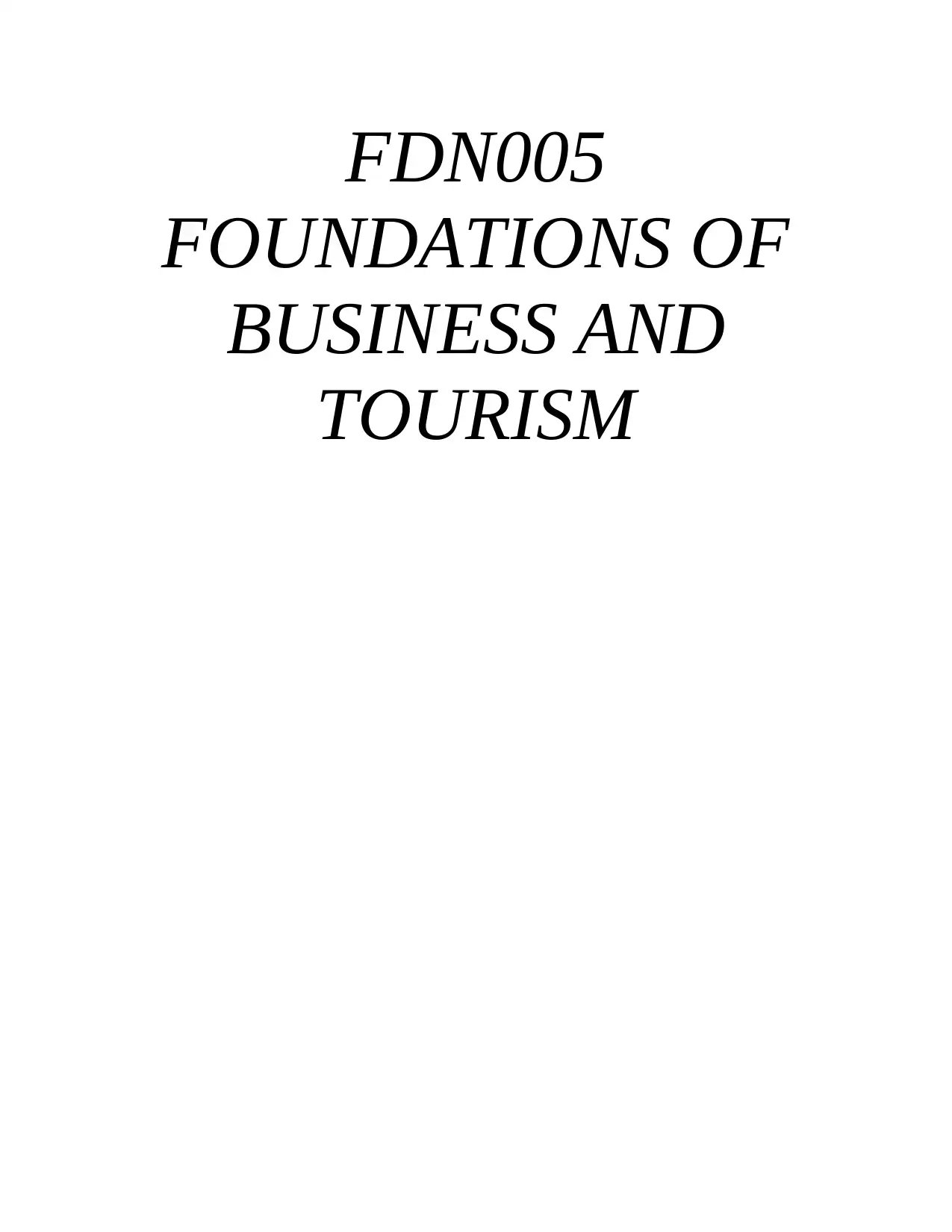
FDN005
FOUNDATIONS OF
BUSINESS AND
TOURISM
FOUNDATIONS OF
BUSINESS AND
TOURISM
Paraphrase This Document
Need a fresh take? Get an instant paraphrase of this document with our AI Paraphraser
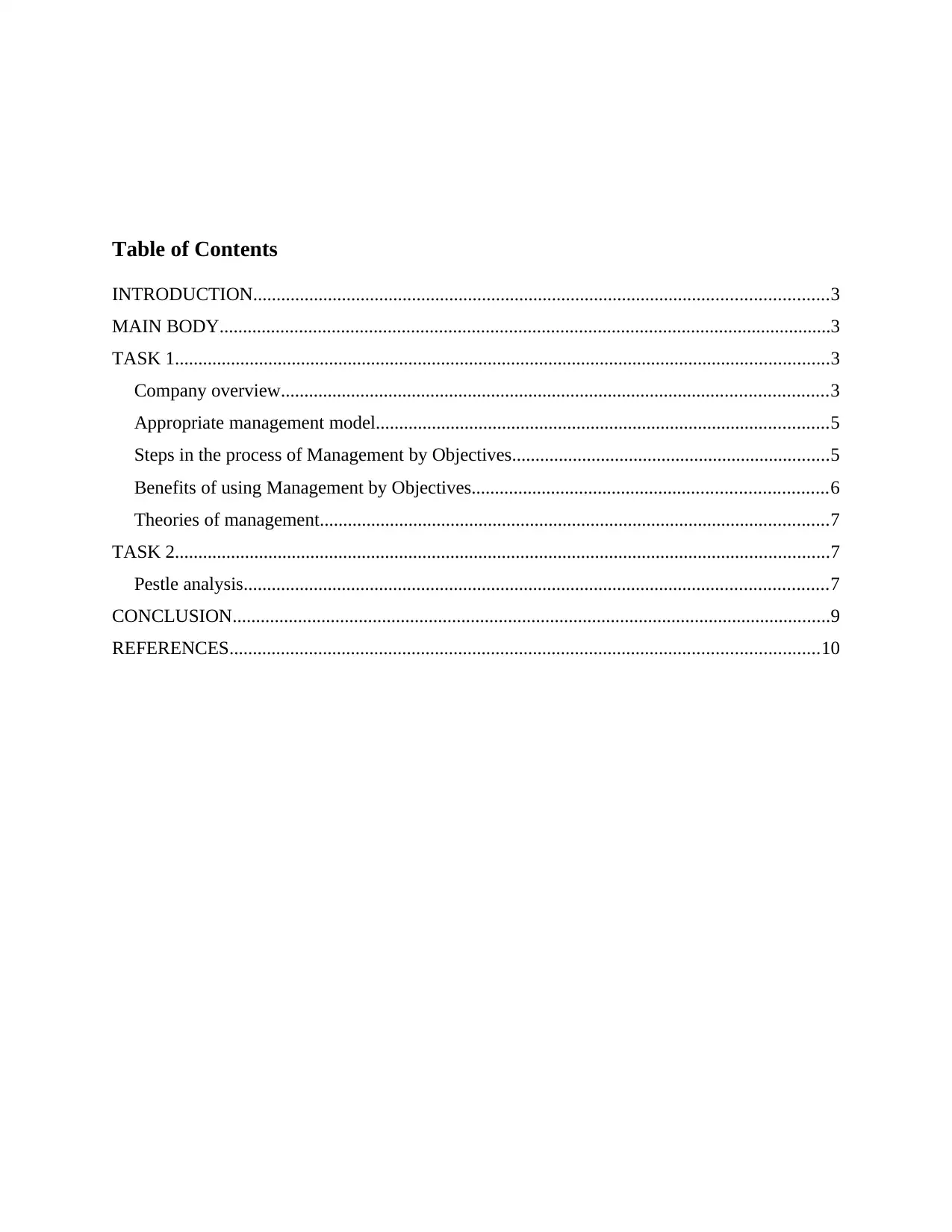
Table of Contents
INTRODUCTION...........................................................................................................................3
MAIN BODY...................................................................................................................................3
TASK 1............................................................................................................................................3
Company overview.....................................................................................................................3
Appropriate management model.................................................................................................5
Steps in the process of Management by Objectives....................................................................5
Benefits of using Management by Objectives............................................................................6
Theories of management.............................................................................................................7
TASK 2............................................................................................................................................7
Pestle analysis.............................................................................................................................7
CONCLUSION................................................................................................................................9
REFERENCES..............................................................................................................................10
INTRODUCTION...........................................................................................................................3
MAIN BODY...................................................................................................................................3
TASK 1............................................................................................................................................3
Company overview.....................................................................................................................3
Appropriate management model.................................................................................................5
Steps in the process of Management by Objectives....................................................................5
Benefits of using Management by Objectives............................................................................6
Theories of management.............................................................................................................7
TASK 2............................................................................................................................................7
Pestle analysis.............................................................................................................................7
CONCLUSION................................................................................................................................9
REFERENCES..............................................................................................................................10
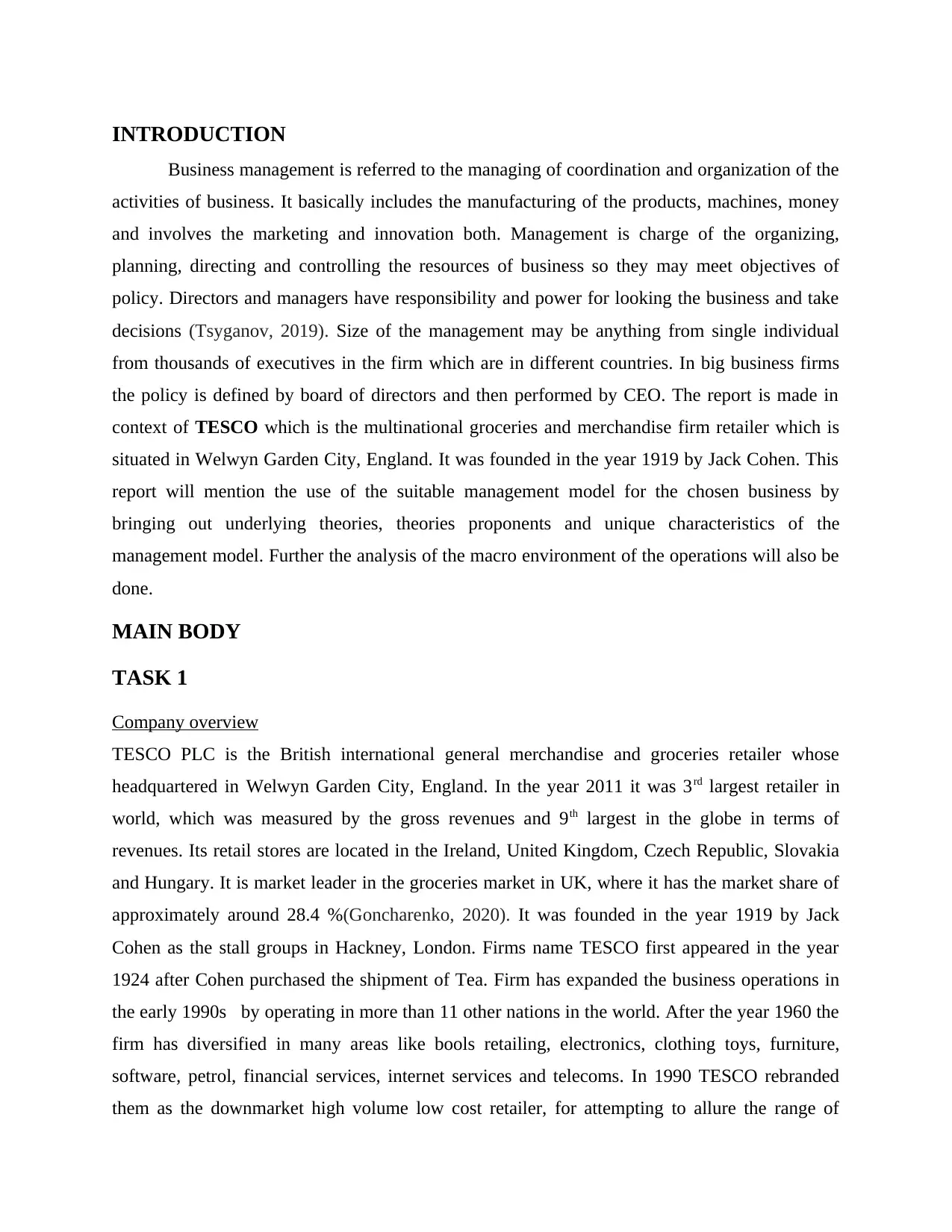
INTRODUCTION
Business management is referred to the managing of coordination and organization of the
activities of business. It basically includes the manufacturing of the products, machines, money
and involves the marketing and innovation both. Management is charge of the organizing,
planning, directing and controlling the resources of business so they may meet objectives of
policy. Directors and managers have responsibility and power for looking the business and take
decisions (Tsyganov, 2019). Size of the management may be anything from single individual
from thousands of executives in the firm which are in different countries. In big business firms
the policy is defined by board of directors and then performed by CEO. The report is made in
context of TESCO which is the multinational groceries and merchandise firm retailer which is
situated in Welwyn Garden City, England. It was founded in the year 1919 by Jack Cohen. This
report will mention the use of the suitable management model for the chosen business by
bringing out underlying theories, theories proponents and unique characteristics of the
management model. Further the analysis of the macro environment of the operations will also be
done.
MAIN BODY
TASK 1
Company overview
TESCO PLC is the British international general merchandise and groceries retailer whose
headquartered in Welwyn Garden City, England. In the year 2011 it was 3rd largest retailer in
world, which was measured by the gross revenues and 9th largest in the globe in terms of
revenues. Its retail stores are located in the Ireland, United Kingdom, Czech Republic, Slovakia
and Hungary. It is market leader in the groceries market in UK, where it has the market share of
approximately around 28.4 %(Goncharenko, 2020). It was founded in the year 1919 by Jack
Cohen as the stall groups in Hackney, London. Firms name TESCO first appeared in the year
1924 after Cohen purchased the shipment of Tea. Firm has expanded the business operations in
the early 1990s by operating in more than 11 other nations in the world. After the year 1960 the
firm has diversified in many areas like bools retailing, electronics, clothing toys, furniture,
software, petrol, financial services, internet services and telecoms. In 1990 TESCO rebranded
them as the downmarket high volume low cost retailer, for attempting to allure the range of
Business management is referred to the managing of coordination and organization of the
activities of business. It basically includes the manufacturing of the products, machines, money
and involves the marketing and innovation both. Management is charge of the organizing,
planning, directing and controlling the resources of business so they may meet objectives of
policy. Directors and managers have responsibility and power for looking the business and take
decisions (Tsyganov, 2019). Size of the management may be anything from single individual
from thousands of executives in the firm which are in different countries. In big business firms
the policy is defined by board of directors and then performed by CEO. The report is made in
context of TESCO which is the multinational groceries and merchandise firm retailer which is
situated in Welwyn Garden City, England. It was founded in the year 1919 by Jack Cohen. This
report will mention the use of the suitable management model for the chosen business by
bringing out underlying theories, theories proponents and unique characteristics of the
management model. Further the analysis of the macro environment of the operations will also be
done.
MAIN BODY
TASK 1
Company overview
TESCO PLC is the British international general merchandise and groceries retailer whose
headquartered in Welwyn Garden City, England. In the year 2011 it was 3rd largest retailer in
world, which was measured by the gross revenues and 9th largest in the globe in terms of
revenues. Its retail stores are located in the Ireland, United Kingdom, Czech Republic, Slovakia
and Hungary. It is market leader in the groceries market in UK, where it has the market share of
approximately around 28.4 %(Goncharenko, 2020). It was founded in the year 1919 by Jack
Cohen as the stall groups in Hackney, London. Firms name TESCO first appeared in the year
1924 after Cohen purchased the shipment of Tea. Firm has expanded the business operations in
the early 1990s by operating in more than 11 other nations in the world. After the year 1960 the
firm has diversified in many areas like bools retailing, electronics, clothing toys, furniture,
software, petrol, financial services, internet services and telecoms. In 1990 TESCO rebranded
them as the downmarket high volume low cost retailer, for attempting to allure the range of
⊘ This is a preview!⊘
Do you want full access?
Subscribe today to unlock all pages.

Trusted by 1+ million students worldwide
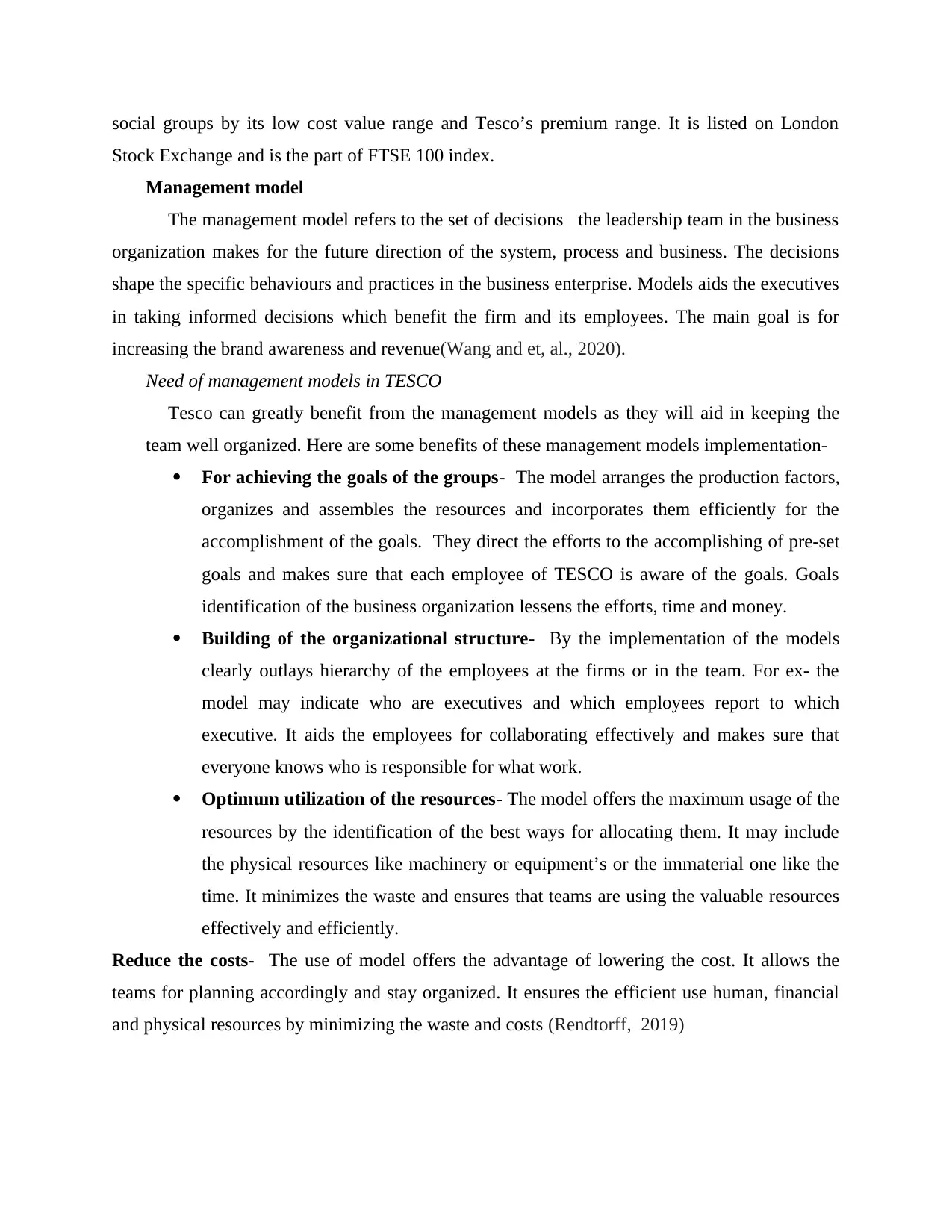
social groups by its low cost value range and Tesco’s premium range. It is listed on London
Stock Exchange and is the part of FTSE 100 index.
Management model
The management model refers to the set of decisions the leadership team in the business
organization makes for the future direction of the system, process and business. The decisions
shape the specific behaviours and practices in the business enterprise. Models aids the executives
in taking informed decisions which benefit the firm and its employees. The main goal is for
increasing the brand awareness and revenue(Wang and et, al., 2020).
Need of management models in TESCO
Tesco can greatly benefit from the management models as they will aid in keeping the
team well organized. Here are some benefits of these management models implementation-
For achieving the goals of the groups- The model arranges the production factors,
organizes and assembles the resources and incorporates them efficiently for the
accomplishment of the goals. They direct the efforts to the accomplishing of pre-set
goals and makes sure that each employee of TESCO is aware of the goals. Goals
identification of the business organization lessens the efforts, time and money.
Building of the organizational structure- By the implementation of the models
clearly outlays hierarchy of the employees at the firms or in the team. For ex- the
model may indicate who are executives and which employees report to which
executive. It aids the employees for collaborating effectively and makes sure that
everyone knows who is responsible for what work.
Optimum utilization of the resources- The model offers the maximum usage of the
resources by the identification of the best ways for allocating them. It may include
the physical resources like machinery or equipment’s or the immaterial one like the
time. It minimizes the waste and ensures that teams are using the valuable resources
effectively and efficiently.
Reduce the costs- The use of model offers the advantage of lowering the cost. It allows the
teams for planning accordingly and stay organized. It ensures the efficient use human, financial
and physical resources by minimizing the waste and costs (Rendtorff, 2019)
Stock Exchange and is the part of FTSE 100 index.
Management model
The management model refers to the set of decisions the leadership team in the business
organization makes for the future direction of the system, process and business. The decisions
shape the specific behaviours and practices in the business enterprise. Models aids the executives
in taking informed decisions which benefit the firm and its employees. The main goal is for
increasing the brand awareness and revenue(Wang and et, al., 2020).
Need of management models in TESCO
Tesco can greatly benefit from the management models as they will aid in keeping the
team well organized. Here are some benefits of these management models implementation-
For achieving the goals of the groups- The model arranges the production factors,
organizes and assembles the resources and incorporates them efficiently for the
accomplishment of the goals. They direct the efforts to the accomplishing of pre-set
goals and makes sure that each employee of TESCO is aware of the goals. Goals
identification of the business organization lessens the efforts, time and money.
Building of the organizational structure- By the implementation of the models
clearly outlays hierarchy of the employees at the firms or in the team. For ex- the
model may indicate who are executives and which employees report to which
executive. It aids the employees for collaborating effectively and makes sure that
everyone knows who is responsible for what work.
Optimum utilization of the resources- The model offers the maximum usage of the
resources by the identification of the best ways for allocating them. It may include
the physical resources like machinery or equipment’s or the immaterial one like the
time. It minimizes the waste and ensures that teams are using the valuable resources
effectively and efficiently.
Reduce the costs- The use of model offers the advantage of lowering the cost. It allows the
teams for planning accordingly and stay organized. It ensures the efficient use human, financial
and physical resources by minimizing the waste and costs (Rendtorff, 2019)
Paraphrase This Document
Need a fresh take? Get an instant paraphrase of this document with our AI Paraphraser
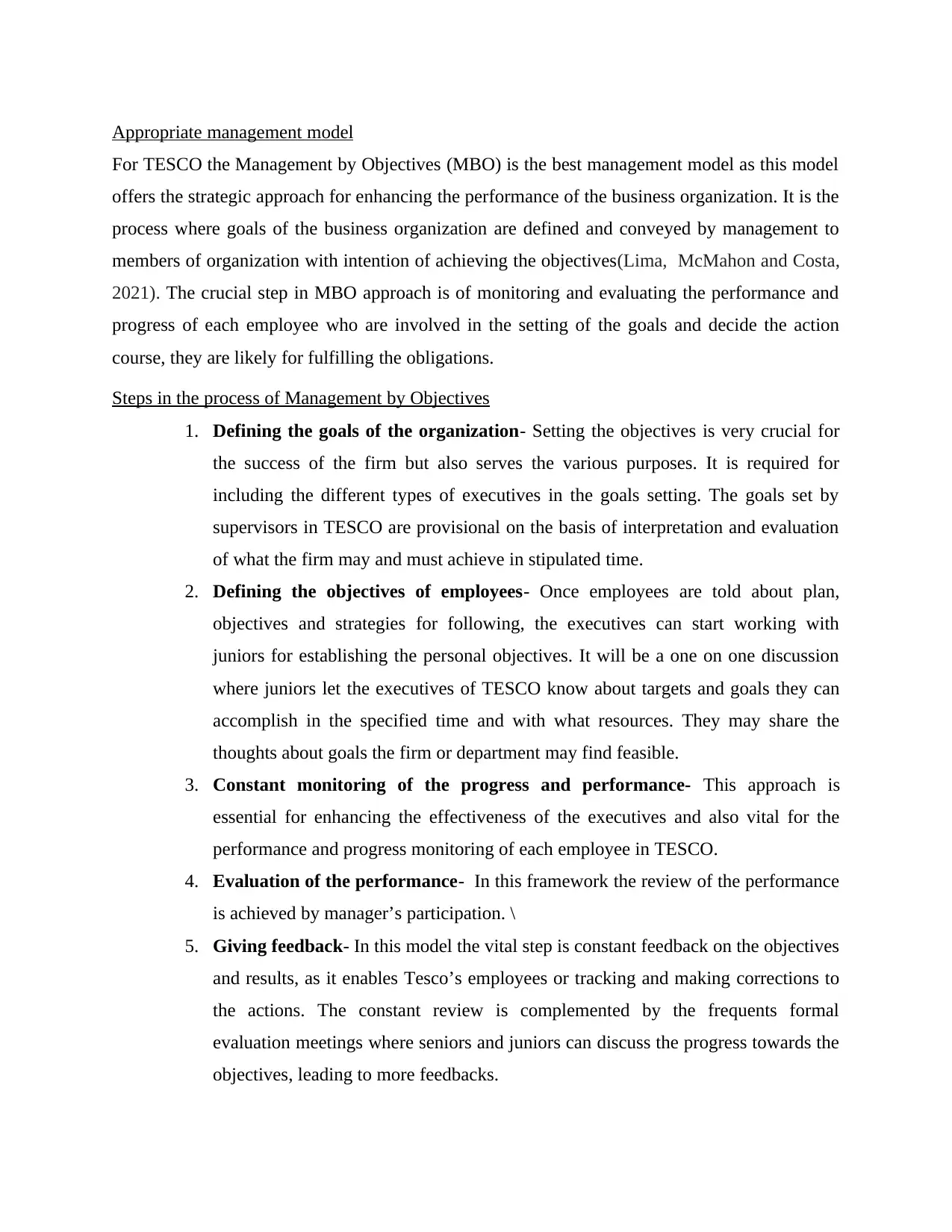
Appropriate management model
For TESCO the Management by Objectives (MBO) is the best management model as this model
offers the strategic approach for enhancing the performance of the business organization. It is the
process where goals of the business organization are defined and conveyed by management to
members of organization with intention of achieving the objectives(Lima, McMahon and Costa,
2021). The crucial step in MBO approach is of monitoring and evaluating the performance and
progress of each employee who are involved in the setting of the goals and decide the action
course, they are likely for fulfilling the obligations.
Steps in the process of Management by Objectives
1. Defining the goals of the organization- Setting the objectives is very crucial for
the success of the firm but also serves the various purposes. It is required for
including the different types of executives in the goals setting. The goals set by
supervisors in TESCO are provisional on the basis of interpretation and evaluation
of what the firm may and must achieve in stipulated time.
2. Defining the objectives of employees- Once employees are told about plan,
objectives and strategies for following, the executives can start working with
juniors for establishing the personal objectives. It will be a one on one discussion
where juniors let the executives of TESCO know about targets and goals they can
accomplish in the specified time and with what resources. They may share the
thoughts about goals the firm or department may find feasible.
3. Constant monitoring of the progress and performance- This approach is
essential for enhancing the effectiveness of the executives and also vital for the
performance and progress monitoring of each employee in TESCO.
4. Evaluation of the performance- In this framework the review of the performance
is achieved by manager’s participation. \
5. Giving feedback- In this model the vital step is constant feedback on the objectives
and results, as it enables Tesco’s employees or tracking and making corrections to
the actions. The constant review is complemented by the frequents formal
evaluation meetings where seniors and juniors can discuss the progress towards the
objectives, leading to more feedbacks.
For TESCO the Management by Objectives (MBO) is the best management model as this model
offers the strategic approach for enhancing the performance of the business organization. It is the
process where goals of the business organization are defined and conveyed by management to
members of organization with intention of achieving the objectives(Lima, McMahon and Costa,
2021). The crucial step in MBO approach is of monitoring and evaluating the performance and
progress of each employee who are involved in the setting of the goals and decide the action
course, they are likely for fulfilling the obligations.
Steps in the process of Management by Objectives
1. Defining the goals of the organization- Setting the objectives is very crucial for
the success of the firm but also serves the various purposes. It is required for
including the different types of executives in the goals setting. The goals set by
supervisors in TESCO are provisional on the basis of interpretation and evaluation
of what the firm may and must achieve in stipulated time.
2. Defining the objectives of employees- Once employees are told about plan,
objectives and strategies for following, the executives can start working with
juniors for establishing the personal objectives. It will be a one on one discussion
where juniors let the executives of TESCO know about targets and goals they can
accomplish in the specified time and with what resources. They may share the
thoughts about goals the firm or department may find feasible.
3. Constant monitoring of the progress and performance- This approach is
essential for enhancing the effectiveness of the executives and also vital for the
performance and progress monitoring of each employee in TESCO.
4. Evaluation of the performance- In this framework the review of the performance
is achieved by manager’s participation. \
5. Giving feedback- In this model the vital step is constant feedback on the objectives
and results, as it enables Tesco’s employees or tracking and making corrections to
the actions. The constant review is complemented by the frequents formal
evaluation meetings where seniors and juniors can discuss the progress towards the
objectives, leading to more feedbacks.
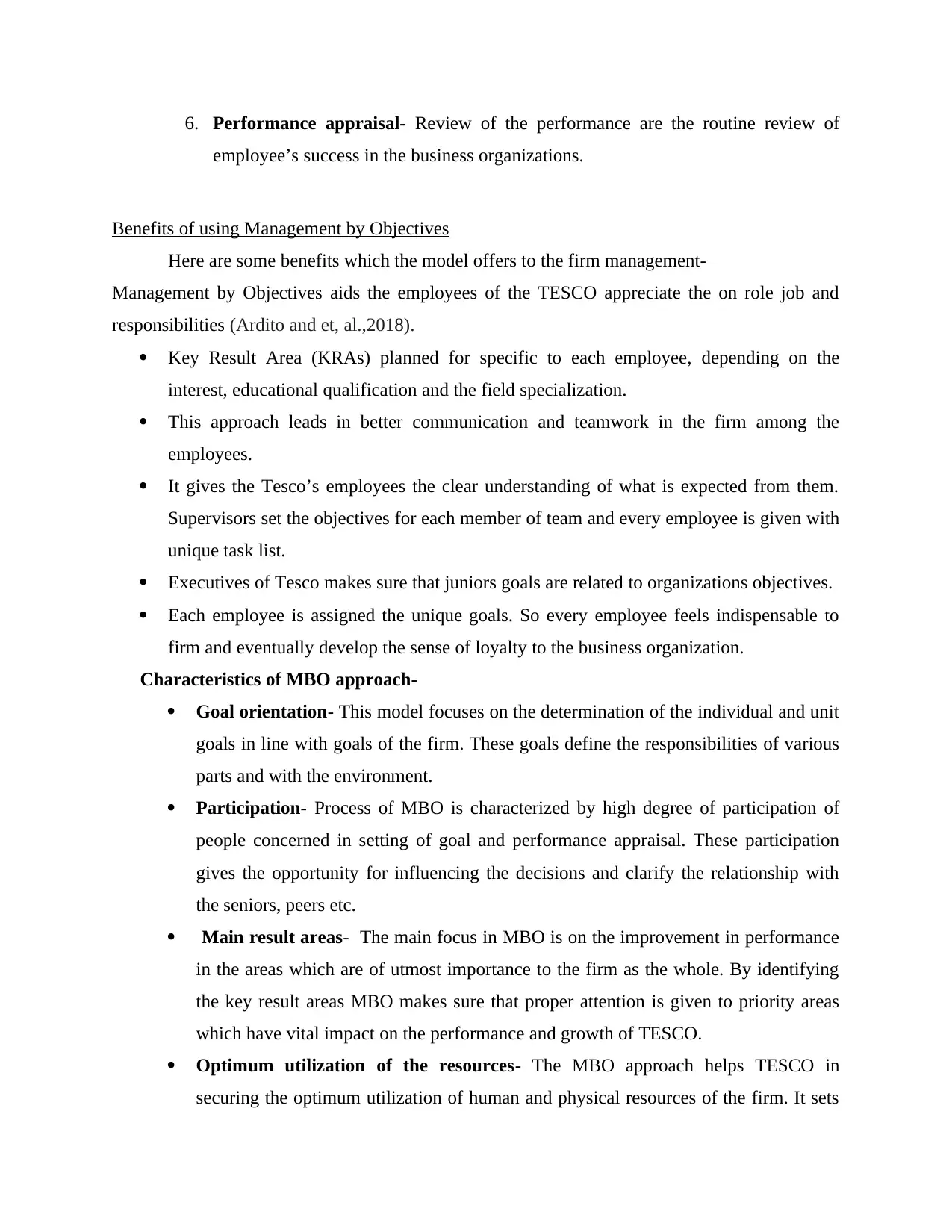
6. Performance appraisal- Review of the performance are the routine review of
employee’s success in the business organizations.
Benefits of using Management by Objectives
Here are some benefits which the model offers to the firm management-
Management by Objectives aids the employees of the TESCO appreciate the on role job and
responsibilities (Ardito and et, al.,2018).
Key Result Area (KRAs) planned for specific to each employee, depending on the
interest, educational qualification and the field specialization.
This approach leads in better communication and teamwork in the firm among the
employees.
It gives the Tesco’s employees the clear understanding of what is expected from them.
Supervisors set the objectives for each member of team and every employee is given with
unique task list.
Executives of Tesco makes sure that juniors goals are related to organizations objectives.
Each employee is assigned the unique goals. So every employee feels indispensable to
firm and eventually develop the sense of loyalty to the business organization.
Characteristics of MBO approach-
Goal orientation- This model focuses on the determination of the individual and unit
goals in line with goals of the firm. These goals define the responsibilities of various
parts and with the environment.
Participation- Process of MBO is characterized by high degree of participation of
people concerned in setting of goal and performance appraisal. These participation
gives the opportunity for influencing the decisions and clarify the relationship with
the seniors, peers etc.
Main result areas- The main focus in MBO is on the improvement in performance
in the areas which are of utmost importance to the firm as the whole. By identifying
the key result areas MBO makes sure that proper attention is given to priority areas
which have vital impact on the performance and growth of TESCO.
Optimum utilization of the resources- The MBO approach helps TESCO in
securing the optimum utilization of human and physical resources of the firm. It sets
employee’s success in the business organizations.
Benefits of using Management by Objectives
Here are some benefits which the model offers to the firm management-
Management by Objectives aids the employees of the TESCO appreciate the on role job and
responsibilities (Ardito and et, al.,2018).
Key Result Area (KRAs) planned for specific to each employee, depending on the
interest, educational qualification and the field specialization.
This approach leads in better communication and teamwork in the firm among the
employees.
It gives the Tesco’s employees the clear understanding of what is expected from them.
Supervisors set the objectives for each member of team and every employee is given with
unique task list.
Executives of Tesco makes sure that juniors goals are related to organizations objectives.
Each employee is assigned the unique goals. So every employee feels indispensable to
firm and eventually develop the sense of loyalty to the business organization.
Characteristics of MBO approach-
Goal orientation- This model focuses on the determination of the individual and unit
goals in line with goals of the firm. These goals define the responsibilities of various
parts and with the environment.
Participation- Process of MBO is characterized by high degree of participation of
people concerned in setting of goal and performance appraisal. These participation
gives the opportunity for influencing the decisions and clarify the relationship with
the seniors, peers etc.
Main result areas- The main focus in MBO is on the improvement in performance
in the areas which are of utmost importance to the firm as the whole. By identifying
the key result areas MBO makes sure that proper attention is given to priority areas
which have vital impact on the performance and growth of TESCO.
Optimum utilization of the resources- The MBO approach helps TESCO in
securing the optimum utilization of human and physical resources of the firm. It sets
⊘ This is a preview!⊘
Do you want full access?
Subscribe today to unlock all pages.

Trusted by 1+ million students worldwide
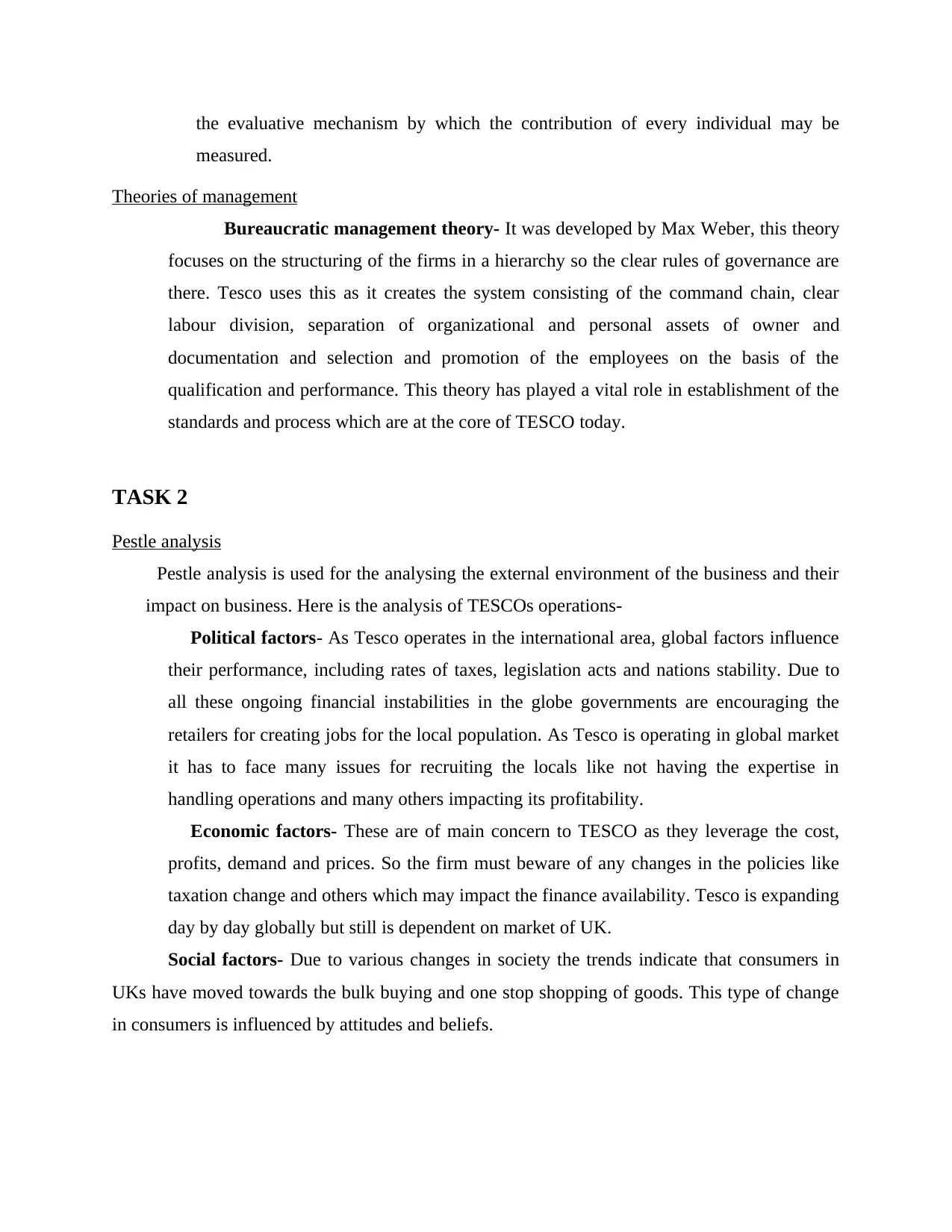
the evaluative mechanism by which the contribution of every individual may be
measured.
Theories of management
Bureaucratic management theory- It was developed by Max Weber, this theory
focuses on the structuring of the firms in a hierarchy so the clear rules of governance are
there. Tesco uses this as it creates the system consisting of the command chain, clear
labour division, separation of organizational and personal assets of owner and
documentation and selection and promotion of the employees on the basis of the
qualification and performance. This theory has played a vital role in establishment of the
standards and process which are at the core of TESCO today.
TASK 2
Pestle analysis
Pestle analysis is used for the analysing the external environment of the business and their
impact on business. Here is the analysis of TESCOs operations-
Political factors- As Tesco operates in the international area, global factors influence
their performance, including rates of taxes, legislation acts and nations stability. Due to
all these ongoing financial instabilities in the globe governments are encouraging the
retailers for creating jobs for the local population. As Tesco is operating in global market
it has to face many issues for recruiting the locals like not having the expertise in
handling operations and many others impacting its profitability.
Economic factors- These are of main concern to TESCO as they leverage the cost,
profits, demand and prices. So the firm must beware of any changes in the policies like
taxation change and others which may impact the finance availability. Tesco is expanding
day by day globally but still is dependent on market of UK.
Social factors- Due to various changes in society the trends indicate that consumers in
UKs have moved towards the bulk buying and one stop shopping of goods. This type of change
in consumers is influenced by attitudes and beliefs.
measured.
Theories of management
Bureaucratic management theory- It was developed by Max Weber, this theory
focuses on the structuring of the firms in a hierarchy so the clear rules of governance are
there. Tesco uses this as it creates the system consisting of the command chain, clear
labour division, separation of organizational and personal assets of owner and
documentation and selection and promotion of the employees on the basis of the
qualification and performance. This theory has played a vital role in establishment of the
standards and process which are at the core of TESCO today.
TASK 2
Pestle analysis
Pestle analysis is used for the analysing the external environment of the business and their
impact on business. Here is the analysis of TESCOs operations-
Political factors- As Tesco operates in the international area, global factors influence
their performance, including rates of taxes, legislation acts and nations stability. Due to
all these ongoing financial instabilities in the globe governments are encouraging the
retailers for creating jobs for the local population. As Tesco is operating in global market
it has to face many issues for recruiting the locals like not having the expertise in
handling operations and many others impacting its profitability.
Economic factors- These are of main concern to TESCO as they leverage the cost,
profits, demand and prices. So the firm must beware of any changes in the policies like
taxation change and others which may impact the finance availability. Tesco is expanding
day by day globally but still is dependent on market of UK.
Social factors- Due to various changes in society the trends indicate that consumers in
UKs have moved towards the bulk buying and one stop shopping of goods. This type of change
in consumers is influenced by attitudes and beliefs.
Paraphrase This Document
Need a fresh take? Get an instant paraphrase of this document with our AI Paraphraser
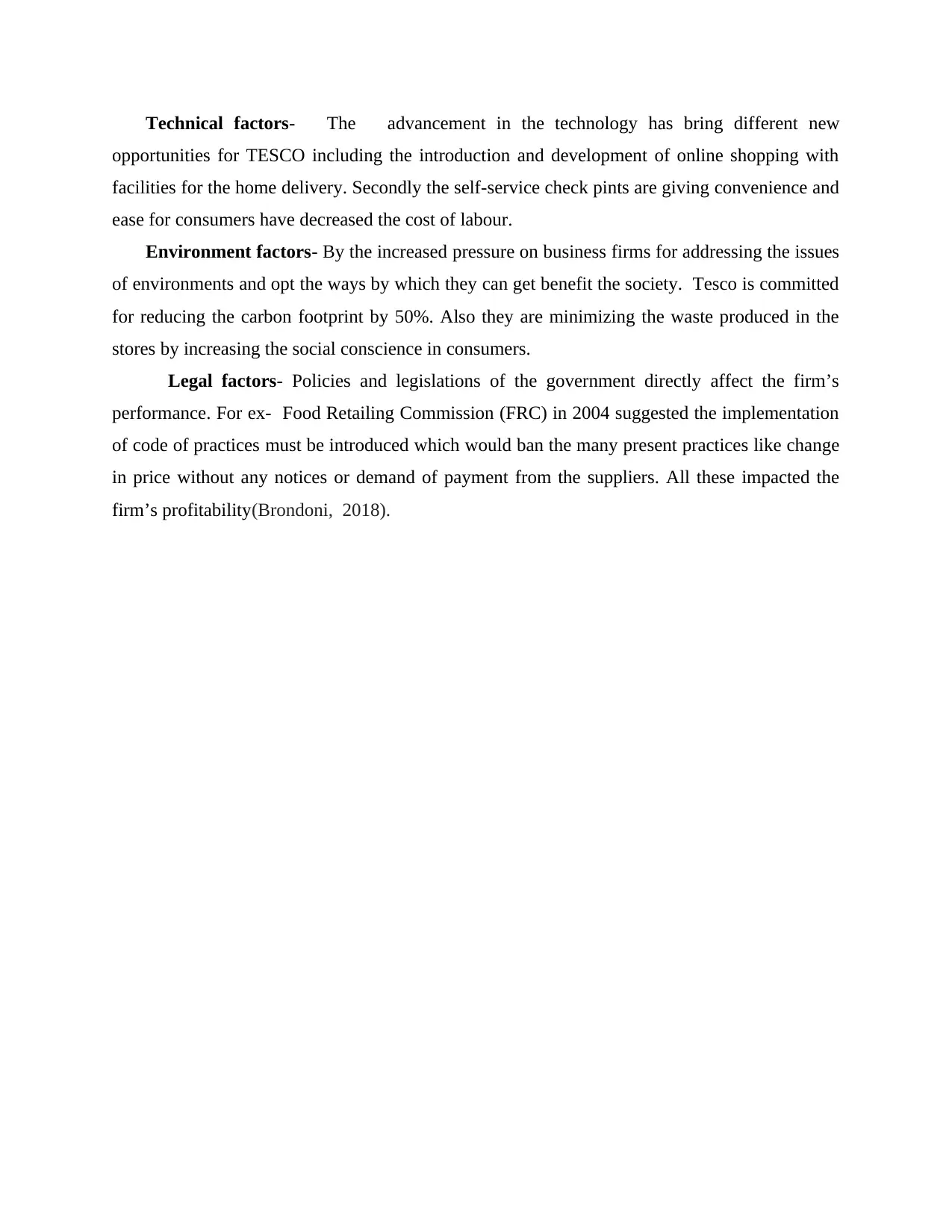
Technical factors- The advancement in the technology has bring different new
opportunities for TESCO including the introduction and development of online shopping with
facilities for the home delivery. Secondly the self-service check pints are giving convenience and
ease for consumers have decreased the cost of labour.
Environment factors- By the increased pressure on business firms for addressing the issues
of environments and opt the ways by which they can get benefit the society. Tesco is committed
for reducing the carbon footprint by 50%. Also they are minimizing the waste produced in the
stores by increasing the social conscience in consumers.
Legal factors- Policies and legislations of the government directly affect the firm’s
performance. For ex- Food Retailing Commission (FRC) in 2004 suggested the implementation
of code of practices must be introduced which would ban the many present practices like change
in price without any notices or demand of payment from the suppliers. All these impacted the
firm’s profitability(Brondoni, 2018).
opportunities for TESCO including the introduction and development of online shopping with
facilities for the home delivery. Secondly the self-service check pints are giving convenience and
ease for consumers have decreased the cost of labour.
Environment factors- By the increased pressure on business firms for addressing the issues
of environments and opt the ways by which they can get benefit the society. Tesco is committed
for reducing the carbon footprint by 50%. Also they are minimizing the waste produced in the
stores by increasing the social conscience in consumers.
Legal factors- Policies and legislations of the government directly affect the firm’s
performance. For ex- Food Retailing Commission (FRC) in 2004 suggested the implementation
of code of practices must be introduced which would ban the many present practices like change
in price without any notices or demand of payment from the suppliers. All these impacted the
firm’s profitability(Brondoni, 2018).
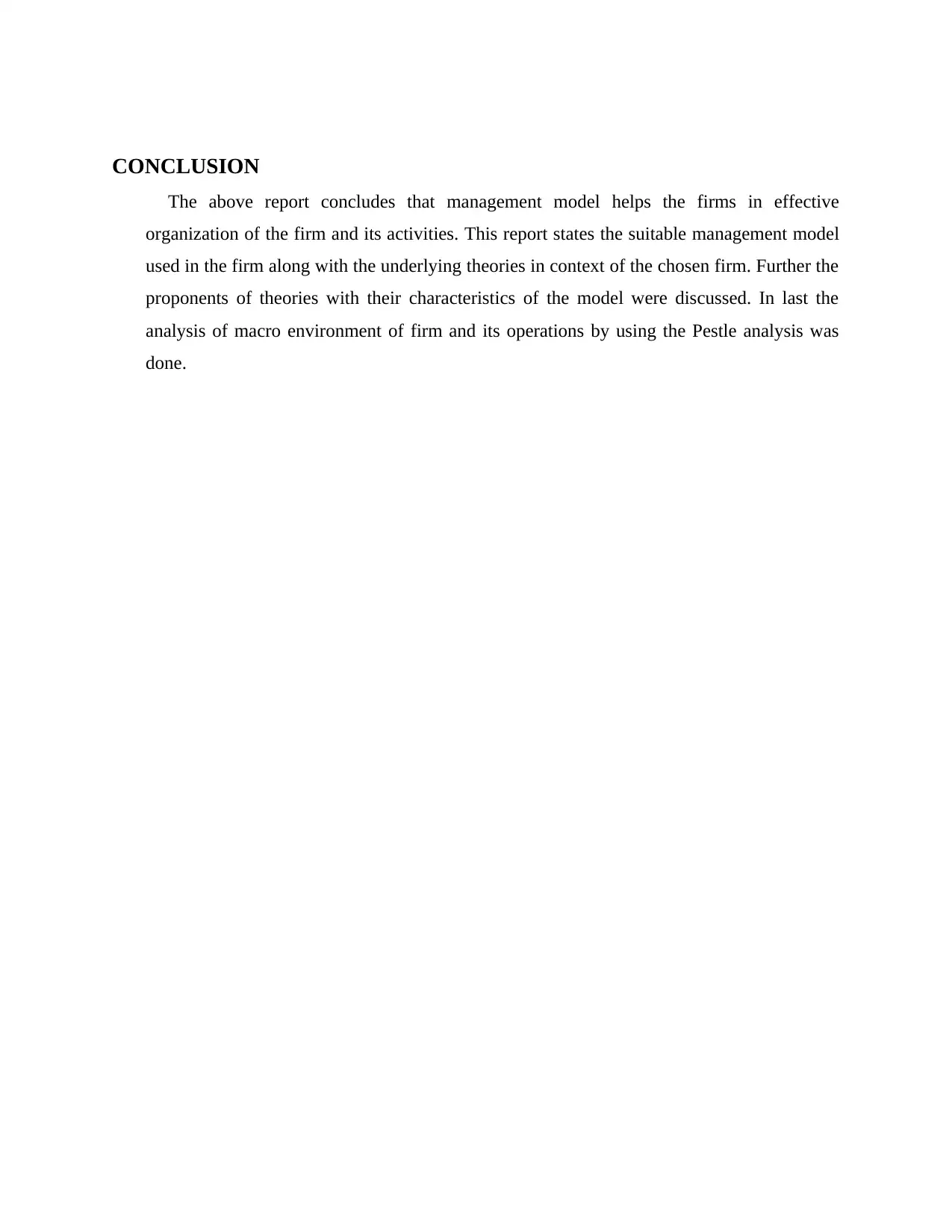
CONCLUSION
The above report concludes that management model helps the firms in effective
organization of the firm and its activities. This report states the suitable management model
used in the firm along with the underlying theories in context of the chosen firm. Further the
proponents of theories with their characteristics of the model were discussed. In last the
analysis of macro environment of firm and its operations by using the Pestle analysis was
done.
The above report concludes that management model helps the firms in effective
organization of the firm and its activities. This report states the suitable management model
used in the firm along with the underlying theories in context of the chosen firm. Further the
proponents of theories with their characteristics of the model were discussed. In last the
analysis of macro environment of firm and its operations by using the Pestle analysis was
done.
⊘ This is a preview!⊘
Do you want full access?
Subscribe today to unlock all pages.

Trusted by 1+ million students worldwide
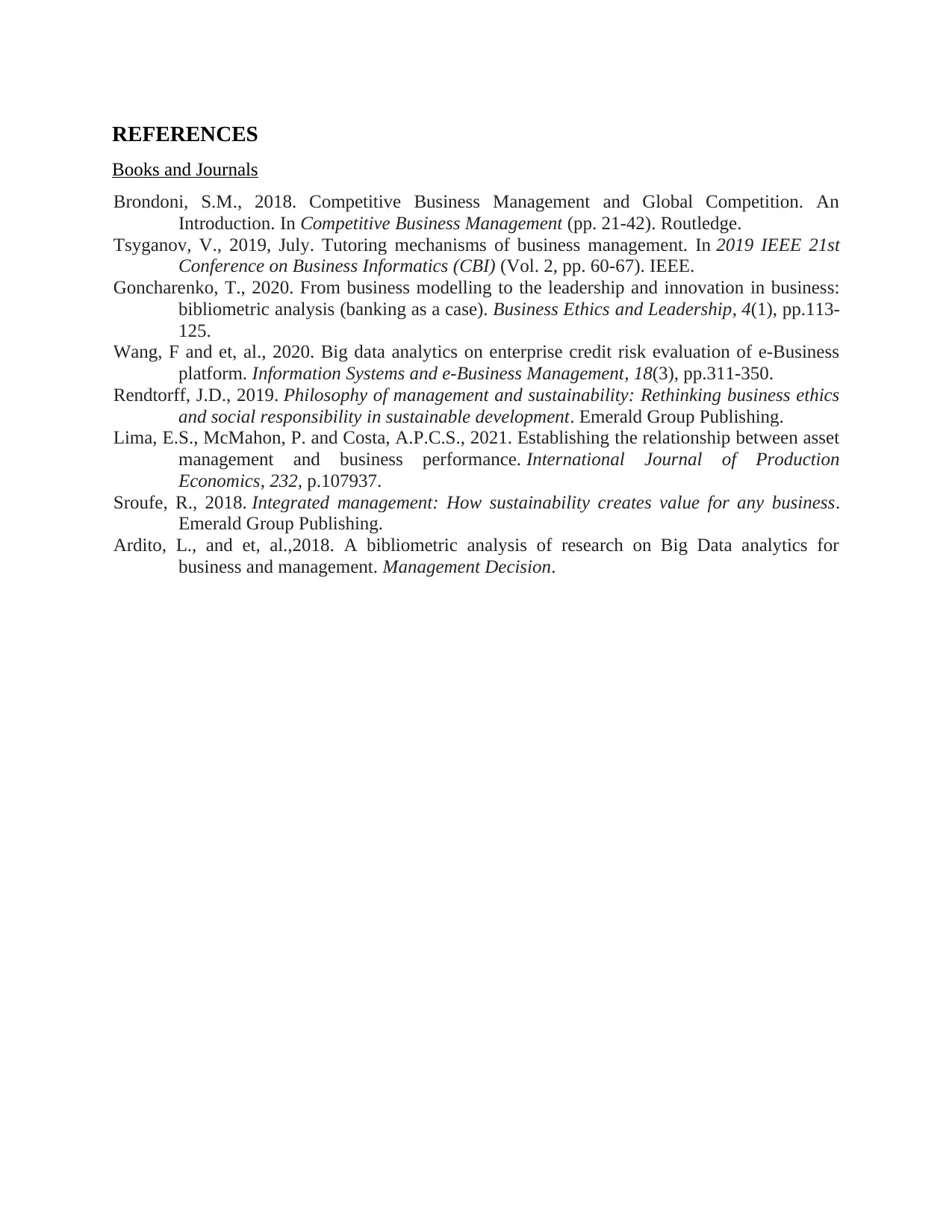
REFERENCES
Books and Journals
Brondoni, S.M., 2018. Competitive Business Management and Global Competition. An
Introduction. In Competitive Business Management (pp. 21-42). Routledge.
Tsyganov, V., 2019, July. Tutoring mechanisms of business management. In 2019 IEEE 21st
Conference on Business Informatics (CBI) (Vol. 2, pp. 60-67). IEEE.
Goncharenko, T., 2020. From business modelling to the leadership and innovation in business:
bibliometric analysis (banking as a case). Business Ethics and Leadership, 4(1), pp.113-
125.
Wang, F and et, al., 2020. Big data analytics on enterprise credit risk evaluation of e-Business
platform. Information Systems and e-Business Management, 18(3), pp.311-350.
Rendtorff, J.D., 2019. Philosophy of management and sustainability: Rethinking business ethics
and social responsibility in sustainable development. Emerald Group Publishing.
Lima, E.S., McMahon, P. and Costa, A.P.C.S., 2021. Establishing the relationship between asset
management and business performance. International Journal of Production
Economics, 232, p.107937.
Sroufe, R., 2018. Integrated management: How sustainability creates value for any business.
Emerald Group Publishing.
Ardito, L., and et, al.,2018. A bibliometric analysis of research on Big Data analytics for
business and management. Management Decision.
Books and Journals
Brondoni, S.M., 2018. Competitive Business Management and Global Competition. An
Introduction. In Competitive Business Management (pp. 21-42). Routledge.
Tsyganov, V., 2019, July. Tutoring mechanisms of business management. In 2019 IEEE 21st
Conference on Business Informatics (CBI) (Vol. 2, pp. 60-67). IEEE.
Goncharenko, T., 2020. From business modelling to the leadership and innovation in business:
bibliometric analysis (banking as a case). Business Ethics and Leadership, 4(1), pp.113-
125.
Wang, F and et, al., 2020. Big data analytics on enterprise credit risk evaluation of e-Business
platform. Information Systems and e-Business Management, 18(3), pp.311-350.
Rendtorff, J.D., 2019. Philosophy of management and sustainability: Rethinking business ethics
and social responsibility in sustainable development. Emerald Group Publishing.
Lima, E.S., McMahon, P. and Costa, A.P.C.S., 2021. Establishing the relationship between asset
management and business performance. International Journal of Production
Economics, 232, p.107937.
Sroufe, R., 2018. Integrated management: How sustainability creates value for any business.
Emerald Group Publishing.
Ardito, L., and et, al.,2018. A bibliometric analysis of research on Big Data analytics for
business and management. Management Decision.
1 out of 10
Related Documents
Your All-in-One AI-Powered Toolkit for Academic Success.
+13062052269
info@desklib.com
Available 24*7 on WhatsApp / Email
![[object Object]](/_next/static/media/star-bottom.7253800d.svg)
Unlock your academic potential
Copyright © 2020–2025 A2Z Services. All Rights Reserved. Developed and managed by ZUCOL.





